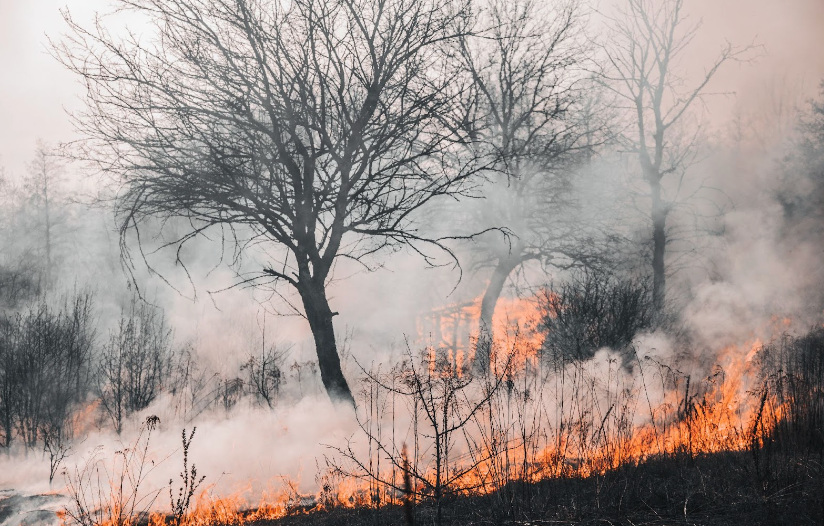What are the Best Air Filters for Wildfire Smoke? | Airzey
If you live in an area that experiences forest fires, you probably know how difficult it is to breathe when there's smoke circulating in the air. Wildfire smoke can have severe health impacts, as it contains a mixture of gasses and fine particles that can harm your lungs and airway.
One way to protect against the harmful effects of wildfire smoke is by using air filters in your HVAC and heating systems. Using air filters in your home or office can significantly improve indoor air quality and protect against the adverse health effects that inhaling wildfire smoke can cause.
Using any air filter is better than using no air filter at all; however, it's important to note that not all air filters are created equal. Choosing an air filter to remove fine particulate matter from the air is a good idea, such as a Nanofiber filter. According to the Environmental Protection Agency, Nanofiber filters can remove over 95% of particulate matter.
These air filters, along with many others, are sold by Airzey, whose team is committed to ensuring that the air you breathe is clean and safe.
Types of Particulates Found in Wildfire Smoke & Their Potential Health Effects
To protect yourself and your loved ones from the harmful effects of wildfire smoke, it's critical to understand the different types of particulate matter wildfire smoke contains. The types of particulate matter found in wildfire smoke can undoubtedly vary depending on the materials being burned, but they usually include:

Fine Particulate Matter (PM2.5)
These particles are 2.5 micrometers or smaller in diameter and can penetrate deep into your lungs. Fine particulate matter can cause respiratory and cardiovascular problems, including asthma, bronchitis, and heart attacks. These particles are 2.5 micrometers or smaller in diameter and can penetrate deep into your lungs. For this reason, they are considered quite dangerous.
Coarse Particulate Matter (PM10)
The particles that comprise coarse particulate matter are typically between 2.5 and 10 micrometers in diameter. These airborne particles are found in larger smoke plumes and can irritate your eyes, nose, and throat. They can also cause specific respiratory issues, such as coughing and difficulty breathing.
Carbon Monoxide (CO)
This odorless and colorless gas is commonly found in forest fire smoke. It can reduce your body's oxygen capacity, resulting in headaches, dizziness, and nausea. Long-term exposure to high levels of carbon monoxide can even be fatal, so it's not something to ignore or mess around with.
Nitrogen Oxides (NOx)
Nitrogen oxides are a group of gasses that can contribute to smog formation and acid rain. Nitrogen oxides can form in the air when fuel is burned at exceptionally high temperatures. They can cause respiratory conditions like bronchitis and emphysema and aggravate asthma symptoms and other pre-existing lung conditions.
Volatile Organic Compounds (VOCs)
Volatile organic compounds are gasses released into the air when materials burn (which happens ten-fold during wildfires). VOCs can irritate your eyes, nose, and throat and cause headaches and nausea.
The Top Available Air Filters for Wildfire Smoke
When protecting yourself against wildfire smoke, the most effective air filters will be those that can remove fine particulate matter, like Nanofiber filters. When it comes to smoke particulates being so small at 2.5 micrometers and smaller, sometimes as small as 0.4 to 0.7 micrometers, you need an efficient fine particle filter.
Nanofiber Filter
Nanofiber filters for your HVAC system can capture 95% of fine air particulates, including wildfire smoke. Extremely fine particles (0.3 micrometers) are easily caught by these filters.
Nanofiber filters are made with an outer layer of nanofiber material with an inner core of fibrous matrix. The unique material filters out more of the tiny particles more efficiently. With a MERV of 13 to 16 with most nanofiber filters, you benefit from fine filtration and maintain efficient airflow so your HVAC fan system doesn’t have to work so hard to process the air in your home.
The incredibly fine nature of the nanofibers themselves (0.3 – 0.5 micrometers) makes them very efficient at high filtration and keeps the particulates from bogging down the substrates. While collecting on the outer fabric, not only can they be cleaned off, but the particulates don’t block air from flowing through the inner substrates maintaining easy airflow through the filter. This means your HVAC system will be energy efficient, and your filter will last longer.

Factors to Look for While Selecting an Air Filter for Wildfire Smoke
When selecting an air filter to combat the harmful effects of wildfire smoke, there are several important factors you'll want to take into consideration:

MERV Rating
When protecting against the effects of wildfire smoke, which contains plenty of PM2.5, choosing a filter with a high MERV rating is imperative. The MERV rating is a standard used to measure the ability of a particular air filter to capture particles of different sizes. The higher the MERV rating, the more efficiently an air filter will capture particles.
It is generally recommended to use an air filter with a MERV rating of at least 13 to effectively remove PM2.5 from the air. It's always a good idea to check the MERV rating of a specific air filter before purchasing it. Nanofiber filters range in MERV ratings from 13 to 16 on average. This is an excellent range for combating the smoke and particulates from wildfires, and it is the same rating required in hospitals for clean air.
Type of Filter
The type of filter you choose to use is essential in protecting yourself and others against the effects of wildfire smoke. Different air filters have various strengths and weaknesses when removing particulate matter and other harmful pollutants from the air.
As previously stated, Nanofiber filters are highly effective at removing fine particulate matter, including PM2.5, from the air and are generally considered the most effective filter for protecting against wildfire smoke. It's important to remember that no matter what type of air filter you decide to get, you'll need to change it regularly to continue functioning properly.
Room Size
When choosing an air filter to protect against the negative effects of wildfire smoke, room size is an important factor that few consider. Implementing a Nanofiber filter into your HVAC system is the easiest way to protect your air quality. Most central air filtration systems have a CADR rating of around 300-600 CFM and can effectively handle the increased airflow required to clean the air in larger spaces. As stated previously, the nature of nanofiber filters makes them require far less power behind the fans to move the air through the nanofiber material.

Maintenance
Maintenance is a significant factor to consider when selecting an air filter that protects against wildfire smoke, as a filter that is not adequately maintained can lose its effectiveness over time. Regular maintenance is required to ensure that your HVAC system's air filter functions optimally and effectively removes pollutants from the air. Otherwise, what's the point?
Your lower-quality filters can require monthly changes. When it comes to nanofiber filters, not only are they capturing more, but they’ll last about 3 months. Where you live will have much to do with how long your filter will last. Homes exposed to more particulates, like those near wildfires, must watch their filter and change them more frequently for peak efficiency.
In contrast, other filters require frequent regular cleaning and maintenance to remove the buildup of particles on the fibers or plates.
Frequently Asked Questions
How Can I Get Rid of Wildfire Smoke?
You can take several actions to reduce the amount of wildfire smoke in your home and protect yourself and your loved ones from its harmful effects. The best way to protect yourself is to stay indoors and close all windows and doors. It's also a good idea to use an air conditioner with a filter that has a high MERV rating.
You should also try to avoid activities that can cause indoor pollution, such as burning candles, using fireplaces, smoking, and cooking with gas stoves. Other than that, stay informed about the air quality in your area and seek medical attention if you're experiencing symptoms like coughing, difficulty breathing, chest pain, or headaches.
What If I Have Central Air and Heating?
If you have central air and heating, you can take a few additional steps to protect yourself from the effects of wildfire smoke particles. First, you should use a high-efficiency air filter, preferably one with a MERV rating of at least 13. Secondly, seal the air ducts in your home to prevent outside air from getting in.

What are Basic Air Filters?
Basic air filters are the most common type in home heating and air conditioning systems. They are usually made of fiberglass or synthetic materials and are designed to remove larger particles from the air, such as dust, lint, pet hair, and pet dander. Basic filters typically have a MERV rating between 1 and 4 and could be more effective at capturing fine particulate matter.
What is the MERV 13?
Merv 13 is a rating for air filters. Filters with a MERV rating of 13 or higher can remove particles as small as 0.3 microns from the air, making them highly effective at trapping allergens, bacteria, wildfire smoke, and other small particles.
Improve Your Indoor Air Quality With Airzey!
Air filters are crucial in protecting people from the harmful effects of wildfire smoke. High-efficiency air filters, such as those rated MERV 13, are particularly effective at trapping small particles, including those found in wildfire smoke. You can use these filters in homes and commercial buildings to help improve indoor air quality and protect against the adverse health effects of wildfire smoke.
While it's important to note that no air filter can eliminate the risk of smoke exposure, using a high-efficiency air filter can significantly reduce the number of smoke particles in your home and help protect you and your loved ones from the harmful particles found in wildfire smoke.
Are you interested in learning more and want to purchase a high-efficiency filter of your very own? Check out Airzey's selection of air filters and find one that suits you today.





